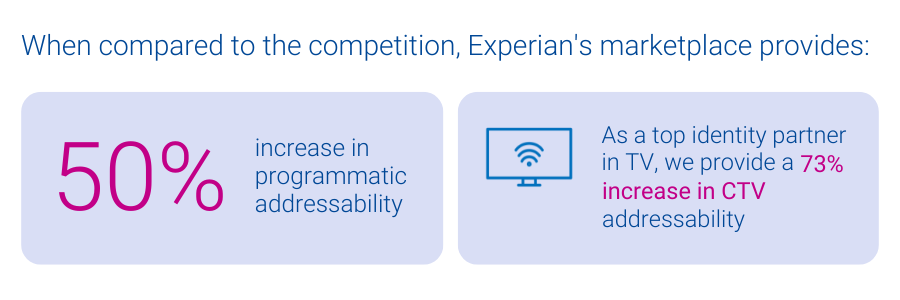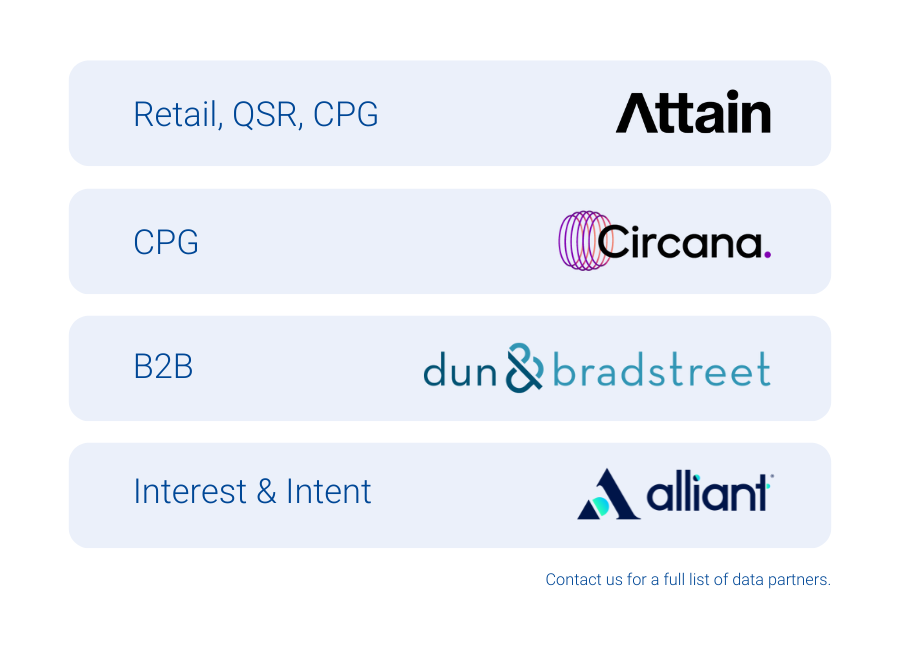
In a perfect world, we’d all have a single, go-to grocery store that carried everything on our shopping list – fresh produce, gourmet coffee beans, rare spices, and maybe even that special-grade olive oil, right alongside our wholesale bulk purchases at unbeatable prices. It would be convenient and efficient, and it’d save a lot of driving around town.
The changing data marketplace: From one-stop shop to specialized selection
For a long time, data buyers enjoyed something similar in their world: a small set of large-scale data marketplaces that offered a wide array of audiences, making it easy to load up on whatever you needed in one place. Not only are there fewer places to pick everything up, but new factors like privacy and signal deprecation are placing a spotlight on quality and addressability.
Just as our dinner plans are growing more ambitious insofar as we want health, flavor, value, and convenience all in one place – so are our data strategies. Instead of a single steak-and-potatoes meal, today’s data marketplace operators might be cooking up a complex menu of campaigns.
“Experian has been a longstanding partner of DISH Media, and we’re excited to be an early adopter of their marketplace which leverages the foundation of their identity solutions to ensure maximum cross-channel reach as we look to expand the breadth and depth of data we use for addressable TV.”
Kemal Bokhari, Head of Data, Measurement & Analytics, DISH Media
As a result, data buyers are beginning to shop around. Some still rely on large-scale marketplaces for familiar staples, but now they have reasons to explore other options. Some are turning to providers known for offering top-tier, transparently sourced segments. Others are focusing on specialty providers that excel in one area.
A more selective approach to data buying
In this environment, choosing where to “shop” for data is becoming more deliberate and selective. Data buyers aren’t just thinking about broad scale; they’re looking to prioritize quality, durability, data privacy, and differentiation. They need to place higher value on data marketplaces that can maintain audience addressability over time, despite signal loss. Sometimes, that means accepting a smaller assortment in exchange for tighter vetting and more reliable targeting. Other times it means mixing and matching – stopping by one marketplace for premium segments and another for cost-friendly, wide-reaching data sets. Either way, they can benefit from having more choices.
“Experian has been a longstanding partner of DISH Media, and we’re excited to be an early adopter of their marketplace which leverages the foundation of their identity solutions to ensure maximum cross-channel reach as we look to expand the breadth and depth of data we use for addressable TV.”
Kemal Bokhari, Head of Data, Measurement & Analytics, DISH Media
Experian’s marketplace: A trusted source for high-quality data
Experian’s vetted and curated blend of data partners and vertically-aligned audiences offers a trusted specialty store for data buyers. Experian’s marketplace, powered by identity graphs that include 126 million households, 250 million individuals, and 4 billion active digital IDs, enables partner audiences to be easily activated and maintain high addressability across display, mobile, and connected TV (CTV) channels. In particular, Experian’s marketplace provides:


The future of data marketplaces: Precision and flexibility matter
The evolution of data marketplaces reflects the industry’s shifting priorities. Data buyers seek specificity, reliability, and adaptability to align with their diverse campaign needs. The best data strategy, much like the best grocery run, isn’t about grabbing everything in one place – it’s about carefully selecting the right ingredients to create the perfect recipe for success. This shift underscores the importance of flexibility and precision as data buyers navigate a landscape shaped by privacy regulations, signal loss, and evolving consumer expectations.

As data marketplaces adapt to meet these demands, they are redefining what it means to deliver value. Experian’s marketplace enables buyers to strike the perfect balance between reach and quality by offering enhanced match rates, precise audience planning, and seamless distribution. In this new era, data buyers have the tools and options to craft campaigns that are impactful and aligned with the increasingly selective and privacy-conscious digital landscape. The key is recognizing that today’s data strategy is about utilizing the strengths of many to create a cohesive and effective whole.
If you’re interested in learning more about Experian’s marketplace or becoming an active buyer or seller in our marketplace, please contact us.
Latest posts

With all the debate and speculation regarding Groupon and its planned IPO, I thought it would be a great time to check back in with our previous analysis of traffic to Groupon and its nearest competitor Living Social. First, to be clear, the above chart measures web-based traffic to both domains and does not include mobile or app specific traffic. Regardless of these exclusions, the drop-off in Groupon traffic this summer has been significant nearly 50% since its peak in the second week of June 2011 compared to last week. During the same time, Living Social has achieved 27% growth in visits to its site. Overall visits to a custom category of Daily Deal & Aggregator sites were down 25% for the same time. So why is there a narrowing of the gap between the two market leaders in group coupons? Perhaps it is simply a case of increased number of competitors and deal fatigue among consumers or simply not enough of the right deals. PriceGrabber® released results from its Local Deals Survey in June, stating that 44% of respondents said they use or search daily deal Websites. However, 52% expressed feeling overwhelmed by the number of bargain-boasting emails they receive on a daily basis. While consumer fatigue may be one factor another key consideration for these sites is to focus on the attracting new and preferred audience segments via the inbox. Currently the audience segments for both Groupon and Living Social are very similar so it will be interesting to see how both sites and category perform heading into the holiday season.

Newton was only half right: Objects in motion tend to stay in motion, but objects at rest are increasingly becoming mobile. That’s the case, at least, when it comes to the world of today’s mobile consumer. According to exclusive research from Experian Simmons, fully 29% of cell phone owners today believe that their cell phone will be the primary device for their entertainment needs, in the future. Furthermore, a recent report by J.P. Morgan estimates that U.S. mobile ad spending will nearly double in 2011 to $1.2 billion. Screen size and limitations on creative, the report says, present obstacles to mobile advertisers. These obstacles and opportunities make it more important than ever for marketers to understand the behaviors and mindset of the mobile consumer. In this first in a series of blog posts, we will explore some key findings presented in the 2011 Mobile Consumer Report recently published recently by Experian Simmons. Media outlets have started to take note, citing the report in articles here and here. Come back to this blog frequently for further updates, or download the full report today. Mobile Market Overview Cell phone ownership among American adults stands at 91%, up from 72% in 2006. The vast majority of teens, too, have joined the mobile revolution, with 74% of those ages 12 to 17 porting a portable phone, up from 59% in 2006. Even tots are getting into the act, with a reported 22% of kids ages 6 to 11 owning a cell phone today. Among adults ages 22 to 24, the idea of not owning a cell is virtually unheard of, with an astounding 98% of consumers in this bracket reporting personally owning a cell phone. While cell ownership among adults age 65+ is the lowest of any adult segment, it is the fastest growing, having increased a relative 52% between 2006 and 2010. Despite the rise in youth owning cell phones, 90% of all mobile phone owners in the U.S. are adults, a rate unchanged since 2008. Percent of Americans that own a cell phone, by age Mobile Service Providers Verizon maintains its position as America’s number one cell phone service provider, with 32% of all adult mobile phone owners saying they are Verizon subscribers as of May 23, 2011. AT&T also has a sizable share of the market, with 28% of mobile phone owners subscribing to AT&T for cell service. Battling for third place are Sprint and T-Mobile, which respectively claim just 11% and 10% of the mobile market. Smaller, often regional, providers may individually have fewer subscribers, but combined, claim an impressive 22% of the total cellular market. Verizon and AT&T will almost certainly continue to dominate the market, especially given the fact that cell phone subscribers are increasingly staying with their provider for an extended period of time. As of May 23, 2011, the average cell phone subscriber had been with their provider for 3 years and 2 months, up from 2 years and 11 months observed at the beginning of 2008. Furthermore, 59% of cell phone subscribers say they’ve been with their current provider for at least 4 years, up from 46% who reported the same in early 2008. 59% of cell phone subscribers say they’ve been with their current provider for at least 4 years Service Providers’ Share of Cell Phone Subscribers Click here to learn more about obtaining vivid consumer research from Experian Simmons and don’t forget to check back here for new blog posts on mobile consumers.

The popularity of flash sale websites with limited time & inventory offerings have grown exponentially over the two years. Online shoppers’ love for the thrill of snagging designer clothing, home décor, travel and even wine have caused visits to the category to increase 368% in July 2011 as compared to the same month two years ago and 109% one year ago. So far in 2011, Nordstrom acquired HauteLook, Amazon entered the fray with MyHabit and recently Saks Fifth Avenue announced the launch of a dedicated flash sale website after offering sale events per week on Saks’ main website. In July 2011, Zulily.com, a website offering sales targeted for women and babies/kids, captured the highest market share of visits at 16%, followed by Ideeli and LivingSocial Escapes. Amazon’s MyHabit ranked 11th, out of the 87 websites in the custom category after only 2 months in operation. Several of the major players over the past six months, the total visits to Ideeli increased 42%, Gilt.com up 14% and Nordstrom’s Hautelook up 8% for July 2011 as compared to February 2011. Total visits for MyHabit jumped 128% for July 2011 as compared to May 2011 when the website launched. The audience for Flash Sales continues to be attractive, and willing to shop – over-indexing against the online population for household incomes over $100k and creditworthy VantageScores of A and B.